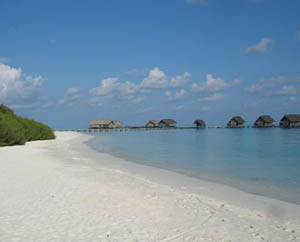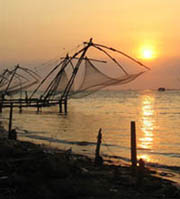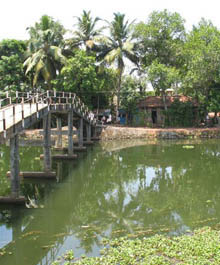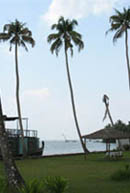|
From Heat and Dust to Sunsets, Spas and Snorkels
Kerala and the Maldives
by Sarah Shuckburgh
Kerala and the Maldives make
the ideal two-centre holiday. One is all-action while the
other is virtually action-free. A perfect combination, says
Sarah Shuckburgh
 There isn’t much to do in the Maldives. Unless you are on
your honeymoon and madly in love, you might get bored after
a few days. However well-appointed your over-water villa,
however shimmering the Indian Ocean, however engrossing your
holiday reading, there’s a limit to how you can fill your
time. On the minuscule holiday islands, there are no
cultural relics, no historical sites, no village cafes and
no local life. There isn’t much to do in the Maldives. Unless you are on
your honeymoon and madly in love, you might get bored after
a few days. However well-appointed your over-water villa,
however shimmering the Indian Ocean, however engrossing your
holiday reading, there’s a limit to how you can fill your
time. On the minuscule holiday islands, there are no
cultural relics, no historical sites, no village cafes and
no local life.
This is what you should do: visit southern India first and
then take a one-hour flight to the Maldives for some
pampering and peace before you fly home. I spent a week in Kerala, exploring the historic city of Kochi, chugging
through inland lakes and backwaters, driving into the
foothills of the Western Ghats and on through ramshackle
towns. We drove along roads thronging with people, animals
and traffic, to the rocky, treacherous coastline at the
southernmost tip of the continent. At Trivandrum, I hopped
on a plane to Male and a speedboat whisked me to Cocoa
Island. India has no beaches to compare with the Maldives,
and the luxurious calm of a five-star desert island was a
perfect sequel to the noise, congestion and dust of India.
 Kerala is perhaps the most welcoming and least alarming
state in India for British tourists. A narrow coastal strip
a quarter the size of England, it makes up only one per cent
of India’s land mass. Although the population density is
twice that of England, the ambience is relaxed, the climate
is tropical and lush, the traditional culture is vibrant,
and the people are friendly and courteous. What’s more, many
of them speak English. The food is delicious, with fish from
the Malabar coast, cooked with spices grown on the Western
Ghats. The first state in the world to have an elected
Communist government, Kerala has the highest standard of
living in India, and boasts almost 100% literacy, an
efficient healthcare system, a strong service sector, and a
comparatively equitable distribution of wealth. Kerala is perhaps the most welcoming and least alarming
state in India for British tourists. A narrow coastal strip
a quarter the size of England, it makes up only one per cent
of India’s land mass. Although the population density is
twice that of England, the ambience is relaxed, the climate
is tropical and lush, the traditional culture is vibrant,
and the people are friendly and courteous. What’s more, many
of them speak English. The food is delicious, with fish from
the Malabar coast, cooked with spices grown on the Western
Ghats. The first state in the world to have an elected
Communist government, Kerala has the highest standard of
living in India, and boasts almost 100% literacy, an
efficient healthcare system, a strong service sector, and a
comparatively equitable distribution of wealth.
 My trip was comfortable from start to finish. I started with
two nights in Kochi, staying in an elegant colonial
bungalow, with time to enjoy the laidback village atmosphere
of the old town centre and its picturesque Chinese fishing
nets, which local fishermen have worked since Kubla Khan’s
days. Then I explored Kerala’s famous backwaters.
Traditional rice-barges can seem dank and dark beneath the
woven roofs, but my private boat had an air-conditioned
bedroom, bathroom and sitting room, sun-deck and canopied
dining area. A chef served delicious Malabar fish as we
chugged quietly across Lake Vembanad, its palm-fringed banks
dotted with small villages. I watched a fishing-eagle dive
into the water and emerge with a wriggling snake in its
beak. A turquoise kingfisher skimmed the lake. Three elegant
cormorants perched on a floating log as wizened fishermen
paddled past in dugout canoes. On the bank, men and women
were preparing shellfish – pouring their catch from baskets
into a steaming cauldron over a log fire. Discarded shells
lay in heaps on the sand. My trip was comfortable from start to finish. I started with
two nights in Kochi, staying in an elegant colonial
bungalow, with time to enjoy the laidback village atmosphere
of the old town centre and its picturesque Chinese fishing
nets, which local fishermen have worked since Kubla Khan’s
days. Then I explored Kerala’s famous backwaters.
Traditional rice-barges can seem dank and dark beneath the
woven roofs, but my private boat had an air-conditioned
bedroom, bathroom and sitting room, sun-deck and canopied
dining area. A chef served delicious Malabar fish as we
chugged quietly across Lake Vembanad, its palm-fringed banks
dotted with small villages. I watched a fishing-eagle dive
into the water and emerge with a wriggling snake in its
beak. A turquoise kingfisher skimmed the lake. Three elegant
cormorants perched on a floating log as wizened fishermen
paddled past in dugout canoes. On the bank, men and women
were preparing shellfish – pouring their catch from baskets
into a steaming cauldron over a log fire. Discarded shells
lay in heaps on the sand.

With a romantic companion, one could spend several days on
board, although the boat is too large to navigate the
narrowest channels. Alternatively, one could sleep in one of
two traditional wooden bungalows, reassembled on the lake
shore, and converted to become chic boutique bedrooms, a
world away from the hurly-burly of the rest of Kerala.
The next morning, there was plenty of hurly-burly as we
drove on through an endless sprawl of shacks and houses,
billboards and shops, many festooned with red
hammer-and-sickle bunting. We passed several communist
rallies, with banners, flags and elaborate floats followed
by hundreds of marchers, immaculate in white dhotis. The
stifling streets contained a maelstrom of gaudily-painted
lorries, black auto-rickshaws, white Ambassador taxis, noisy
motorbikes and wobbling bicycles. Buses lurched past, with
women crowded into the back rows. Scooters carried whole
families - children crammed each side of the driver, the
mother perched sideways at the back, her sari fluttering.
Everywhere, rubbish lay in deep drifts.
Traffic police supervised congested junctions from podiums
shaded by concrete parasols. The roadsides swarmed with
pedestrians - dark-skinned men with skinny legs poking from
folded lunghis and grubby towels draped over shoulders; tiny
women in jewel-coloured saris glided smoothly through the
crowds, water-pots balanced gracefully on their heads.

At dusk, my driver swung off the main road and wound up a
red earth track into the fertile foothills of the Western
Ghats. We stayed the night in a 1920s estate bungalow –
until recently a rambling family home, and still visited by
the octogenarian owner. It had a pleasantly nostalgic air –
high ceilings, shuttered windows, four-poster beds and hefty
colonial furniture. The next morning, I rode an elephant
called Lakshmi. Precariously perched on an eiderdown astride
her massive shoulders, I felt very small and far from the
ground. But as we lurched along village lanes, I grew
accustomed to Lakshmi’s deeply fissured skin, her black
bristly head and huge ears which flapped like wings.
Loosening my white-knuckled grip, I began to enjoy the
aerial views of coffee and tea plantations, groves of
cinnamon, fields of cardamom and ginger, and rubber trees
from which coconut shells dangled beneath gashes in the
bark, to collect sap.
 Continuing south towards the tip of India, we motored
through an endless ribbon development, in which an
occasional traditional wooden illam survived, sandwiched
between half-finished concrete buildings and dilapidated
shacks. We passed cashew trees with embryonic nuts dangling
from clusters of green pods, coconut groves planted for coir
rope and matting, and stalls selling mangoes, jackfruit and
bananas. For a time, the road followed a series of
backwaters, the surface clogged with purple hyacinths.
Beyond the raised dyke, a lagoon shimmered in the sun. By
small waterside houses, women washed clothes while their
bare-chested husbands stood in wooden gondolas, hurling huge
nets out over the water. Continuing south towards the tip of India, we motored
through an endless ribbon development, in which an
occasional traditional wooden illam survived, sandwiched
between half-finished concrete buildings and dilapidated
shacks. We passed cashew trees with embryonic nuts dangling
from clusters of green pods, coconut groves planted for coir
rope and matting, and stalls selling mangoes, jackfruit and
bananas. For a time, the road followed a series of
backwaters, the surface clogged with purple hyacinths.
Beyond the raised dyke, a lagoon shimmered in the sun. By
small waterside houses, women washed clothes while their
bare-chested husbands stood in wooden gondolas, hurling huge
nets out over the water.
Our final stop in Kerala was at a seaside hotel with 21
traditional illam bungalows reassembled above a sandy cove
on grey, rounded rocks which reminded me of Lakshmi’s
wrinkly rump. Out in the bay, fishermen balanced on
weather-beaten planks, searching for cuttlefish, mackerel
and sardines. Bathing here is dangerous because of the
steeply shelving beach, the pounding w aves and the strong
undertow. I was knocked over and tumbled as if I were in a
washing machine – and I soon opted for a more relaxing
option in the hotel’s spa. After an opening benediction, my
tiny therapist smothered my naked body with dark brown oil,
scrubbed me with gravel and sluiced me with ghee - an
ancient ayervedic routine designed to eliminate toxic
imbalances. aves and the strong
undertow. I was knocked over and tumbled as if I were in a
washing machine – and I soon opted for a more relaxing
option in the hotel’s spa. After an opening benediction, my
tiny therapist smothered my naked body with dark brown oil,
scrubbed me with gravel and sluiced me with ghee - an
ancient ayervedic routine designed to eliminate toxic
imbalances.
I was thus already quite relaxed when I left Kerala, but the
astonishing calm of Cocoa Island completed the rest cure.
Few passengers transfer from Trivandrum to Male, and I was
the only tourist on the short flight. Despite a law that 60%
of hotel staff must be Maldivian, luxury hotels on the
archipelago mainly recruit staff from abroad. Levels of
poverty and unemployment in the capital and on other
inhabited islands remain high - Maldivians are not the main
beneficiaries of the tourist industry.
Calls to prayer wafted over from a nearby island, but for
two days, I put sociological concerns to one side. I basked
in warm, translucent shallows, snorkelled through s unlit
shoals of fish too brightly coloured and dazzling to seem
true, and peered anxiously over the precipitous edge of the
reef into dark, unimaginable depths. I watched the graceful
progress of a pod of dolphins; I dined on delicious spiced
fish and tropical fruit; I strolled on blisteringly hot,
icing-sugar sand from one end of the island to the other –
600 paces. I was massaged in a cabin overlooking turquoise
sea and sky, and then, from my private verandah, I watched
dramatic sunsets, with traditional dhonis silhouetted
against an apricot horizon. At night, torrential rainstorms
pummelled the thatch and lulled me to sleep. unlit
shoals of fish too brightly coloured and dazzling to seem
true, and peered anxiously over the precipitous edge of the
reef into dark, unimaginable depths. I watched the graceful
progress of a pod of dolphins; I dined on delicious spiced
fish and tropical fruit; I strolled on blisteringly hot,
icing-sugar sand from one end of the island to the other –
600 paces. I was massaged in a cabin overlooking turquoise
sea and sky, and then, from my private verandah, I watched
dramatic sunsets, with traditional dhonis silhouetted
against an apricot horizon. At night, torrential rainstorms
pummelled the thatch and lulled me to sleep.
Two days in paradise were enough. I felt utterly restored,
and ready to return to reality.
Sarah travelled with Greaves Travel:
www.greavesindia.com
First published by the Telegraph
©SarahShuckburgh |